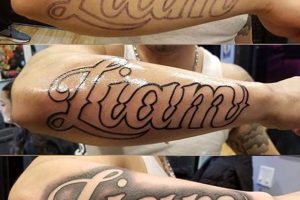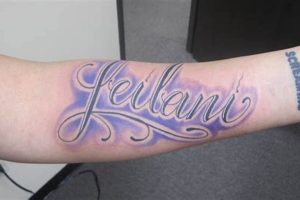Permanent body art incorporating children’s names offers a lasting tribute to familial bonds. This can range from simple name inscriptions to more complex designs incorporating birthdates, portraits, or symbolic imagery representing the parent-child relationship. For instance, a parent might choose a design featuring their children’s names intertwined with a tree of life, symbolizing growth and connection.
Choosing to permanently mark one’s body with a child’s name reflects a deep and enduring commitment. This form of expression allows individuals to carry a constant reminder of their children and the love they represent. Throughout history, various cultures have practiced forms of body modification to signify familial ties and important life events, and incorporating children’s names into tattoos represents a contemporary manifestation of this tradition. The enduring nature of tattoos makes them a powerful symbol of lifelong connection.
This exploration delves into various design considerations, stylistic options, placement choices, and responsible practices for those considering permanent body art honoring their children. Topics include design inspiration, artistic styles, practical considerations like size and placement, as well as the importance of selecting a reputable and experienced artist.
Tips for Designing Childrens’ Name Tattoos
Careful planning ensures a meaningful and aesthetically pleasing tribute. Consider these factors before committing to a permanent design.
Tip 1: Consider Placement Carefully: Placement impacts visibility and how the design interacts with body contours. A name tattooed on the inner wrist offers personal reflection, while a back piece provides a larger canvas for more elaborate designs.
Tip 2: Explore Font Options: Font selection dramatically influences the overall aesthetic. Script fonts convey elegance, while block letters project boldness. Research various fonts to find one that complements the chosen name and design.
Tip 3: Incorporate Symbolic Imagery: Enhance the design with meaningful symbols. Birth flowers, zodiac signs, or shared hobbies can add depth and personalization. Consider elements that reflect the child’s personality or shared experiences.
Tip 4: Plan for Future Additions: If anticipating more children, consider a design that allows for future name additions without appearing cluttered or unbalanced. Discuss potential expansion plans with the tattoo artist during the initial consultation.
Tip 5: Prioritize Artist Selection: Research reputable and experienced tattoo artists specializing in the desired style. Review portfolios and seek recommendations to ensure artistic skill and hygiene standards.
Tip 6: Size Matters: Choose a size appropriate for the chosen placement and design complexity. Small, intricate details may not age well in larger designs. Discuss scaling options with the artist.
Tip 7: Reflect on the Design: Spend ample time considering the design’s long-term implications. Avoid impulsive decisions. A well-considered tattoo serves as a timeless representation of familial love.
Thoughtful consideration of these elements contributes to a tattoo that resonates with personal meaning and stands the test of time as a beautiful tribute.
By embracing these guidelines, individuals can approach this permanent form of expression with confidence and create a lasting homage to their children.
1. Placement
Placement is a crucial factor in name tattoo design, impacting visibility, aesthetics, and personal significance. Thoughtful placement enhances the design’s meaning and ensures it harmonizes with the body’s natural contours.
- Intimate Placement:
Locations like the inner wrist, ribcage, or nape of the neck offer discreet visibility, allowing for personal reflection and close physical proximity to the inscribed names. This placement often signifies a deep, personal connection.
- Prominent Placement:
Areas like the forearm, upper arm, or shoulder provide higher visibility, allowing for easier sharing and public display of the tribute. This choice may reflect a desire to openly express one’s familial pride.
- Functional Placement:
Positioning names over the heart or near a significant birthmark adds symbolic weight, connecting the design to physical embodiment and personal history. This choice further emphasizes the intrinsic link between parent and child.
- Spacial Placement:
Larger canvases, such as the back or chest, accommodate more complex designs, integrating multiple names, portraits, or symbolic imagery. The increased space allows for greater artistic expression and more elaborate storytelling within the tattoo itself.
Ultimately, placement decisions should reflect individual preferences and the desired balance between personal meaning and public expression. The chosen location significantly contributes to the overall impact and narrative of the tattoo, reinforcing its role as a lasting tribute.
2. Font
Font selection significantly impacts the overall aesthetic and legibility of name tattoos. Typography conveys specific emotions and styles, influencing how the inscribed names are perceived and interpreted. Careful consideration of font characteristics ensures a visually appealing and meaningful tribute.
- Script Fonts:
Script fonts, with their flowing, cursive-like appearance, evoke elegance, intimacy, and a sense of classicism. Variations within script fonts, from formal calligraphy to casual handwriting styles, offer diverse options for expressing personal taste and the unique bond with a child. A flowing script might suit a daughter’s name, while a bolder script may suit a son’s.
- Block Fonts:
Block fonts, characterized by their strong, straight lines, project boldness, clarity, and modernity. These fonts offer excellent legibility, ensuring the names remain easily readable over time. Variations within block fonts, from traditional serif styles to contemporary sans-serif options, offer diverse options to complement individual aesthetics. Simpler block fonts may be suitable for minimalist designs.
- Decorative Fonts:
Decorative fonts offer unique and artistic expressions, often incorporating intricate details or thematic elements. These fonts can add a personalized touch, reflecting shared interests or the child’s personality. However, careful consideration of legibility and long-term aesthetics is crucial when selecting decorative fonts, as overly complex designs can become less clear over time.
- Custom Fonts:
Custom fonts offer the ultimate personalization, allowing for the creation of truly unique lettering that holds special meaning. This option allows for incorporating elements of a child’s handwriting or creating a font inspired by shared experiences. Working closely with a skilled tattoo artist is essential for developing a custom font that is both aesthetically pleasing and technically sound for tattoo application.
Selecting an appropriate font requires balancing personal preferences with the overall design concept. The chosen font should complement the chosen names, symbolic imagery, and placement, resulting in a harmonious and meaningful composition. Effective font selection elevates the tattoo from a simple inscription to a personalized work of art.
3. Style
Style significantly influences the overall aesthetic and narrative of name tattoos honoring sons. Distinct stylistic choices reflect personal preferences, cultural influences, and the desired emotional impact of the design. Understanding the diverse range of stylistic options empowers informed decisions, resulting in a tattoo that resonates with both personal and artistic significance.
Several styles frequently employed in name tattoo designs include:
- Realism: Captures lifelike detail, often incorporating portraiture of the sons or significant objects associated with them. This style emphasizes accurate representation and visual fidelity.
- Traditional: Employs bold lines, vibrant colors, and iconic imagery, often drawing inspiration from classic tattoo motifs. This style offers a timeless and recognizable aesthetic.
- Watercolor: Mimics the fluid and vibrant nature of watercolor paintings, creating a soft and artistic effect. This style emphasizes color blending and artistic expression.
- Tribal: Incorporates bold, black ink designs inspired by indigenous art forms. This style often carries symbolic meaning and cultural significance.
- Minimalist: Favors clean lines, simple designs, and often monochromatic color palettes. This style emphasizes clarity and understated elegance. A minimalist approach might involve solely the sons’ names in a simple font.
- Geometric: Utilizes geometric shapes and patterns to create structured and visually striking designs. This style can be abstract or representational, offering a modern and versatile approach.
Selecting an appropriate style requires considering the desired visual impact, the symbolism embedded within the chosen style, and the artist’s expertise. For example, a realism-focused parent might commission a portrait of their sons interwoven with their names in a flowing script, while a parent drawn to minimalism might choose simple block lettering for the names alone. Harmonizing the chosen style with other design elements, such as font and placement, ensures a cohesive and impactful final result.
4. Symbolism
Symbolism imbues name tattoos honoring sons with deeper meaning, transforming simple inscriptions into powerful personal narratives. Incorporating symbolic elements allows individuals to express the unique qualities of their relationships with their children, commemorating shared experiences, values, and aspirations. The chosen symbols resonate with personal significance, adding layers of emotional depth to the tribute.
Consider the following examples:
- Celtic Knots: Represent eternal connection and unbroken bonds, symbolizing the enduring parent-child relationship.
- Trees of Life: Symbolize growth, strength, and the interconnectedness of family, reflecting the nurturing role of a parent and the flourishing lives of their sons.
- Anchors: Represent stability, security, and steadfast love, embodying the unwavering support a parent provides.
- Lions: Symbolize courage, strength, and protection, reflecting a parent’s desire to safeguard their children.
- Compass: Symbolize guidance, direction, and a shared journey through life, representing the parent’s role in shaping their sons’ paths.
- Birthstones/Flowers: Represent individual personalities and birth months, adding a personalized touch to each son’s name.
- Shared Hobbies/Interests: Incorporating imagery related to shared hobbies or interests (e.g., musical notes, sports equipment) further personalizes the design, commemorating shared experiences and passions.
Thoughtful selection of symbols requires considering personal and cultural meanings. A symbol’s resonance amplifies the emotional impact of the tattoo, transforming it from a simple name inscription into a profound expression of familial love and connection. Understanding the symbolism within a design allows others to appreciate the deeper layers of meaning embedded within the artwork, fostering connection and shared understanding. The interplay between names and symbols creates a powerful visual narrative, encapsulating the essence of the parent-child bond in a lasting and meaningful tribute.
5. Size
Size is a critical design element in name tattoos, significantly impacting legibility, aesthetics, and the overall balance of the composition. Careful consideration of size ensures the chosen names remain clear and visually appealing over time, while also harmonizing with the chosen placement, font, and accompanying imagery.
- Scale and Placement:
Size must complement the chosen body placement. A small, intricate design might suit the wrist or ankle, while a larger, more expansive design might be better suited for the back or chest. Disproportionately large designs on smaller areas can appear cluttered, while small designs on larger areas might lack impact.
- Legibility Over Time:
Intricate details and small font sizes can become less distinct as the tattoo ages. Choosing a size that allows for clear legibility over time is crucial, especially for designs incorporating multiple names or complex imagery. Consulting with an experienced tattoo artist ensures appropriate scaling for long-term clarity.
- Visual Impact and Balance:
Size contributes to the overall visual impact of the tattoo. Larger designs command more attention, while smaller designs offer a more understated aesthetic. Balancing the size of the names with any accompanying imagery ensures a harmonious composition, preventing one element from overpowering the others.
- Practical Considerations:
Size also influences the time and cost of the tattoo. Larger, more complex designs require more time and multiple sessions, increasing the overall investment. Considering practical limitations and budget constraints is essential during the design process.
Effective size consideration ensures the tattoo remains aesthetically pleasing and legible throughout its lifetime. Harmonizing size with other design elements, such as placement, font, and style, results in a well-balanced and meaningful tribute honoring sons. A thoughtfully sized tattoo reflects a considered approach, demonstrating a commitment to creating a lasting and visually appealing piece of body art.
6. Artist Skill
A skilled artist is paramount when realizing the vision of a name tattoo honoring sons. Technical expertise, artistic ability, and experience directly influence the final result, impacting the aesthetics, longevity, and overall meaning embedded within the design. Selecting an artist with the appropriate skill set is a crucial investment in a tribute intended to last a lifetime.
- Technical Proficiency:
Technical skill encompasses line work, shading, color saturation, and needle control. Clean, consistent lines are essential for legibility and visual appeal, particularly with intricate scripts or detailed imagery. Proper shading and color saturation contribute to depth and dimensionality, ensuring the tattoo remains vibrant over time. Precise needle control minimizes scarring and ensures even ink distribution, resulting in a smooth and professional finish. A technically proficient artist executes the design with precision, transforming the concept into a polished piece of body art. For example, an artist skilled in fine line work can create delicate lettering that remains legible even at a small scale, while an artist proficient in color realism can capture lifelike portraits of the sons.
- Artistic Vision:
Artistic vision encompasses composition, design flow, and the ability to translate concepts into compelling visuals. A skilled artist understands how different elements interact within a tattoo design, balancing names, symbols, and other imagery to create a harmonious composition. They possess a keen eye for aesthetics, ensuring the design flows naturally with the body’s contours and complements the individual’s style. Furthermore, a skilled artist can collaborate effectively, interpreting the client’s vision and offering creative suggestions to enhance the design’s overall impact. This collaborative process ensures the final result aligns with the intended message and emotional resonance. An artist with a strong artistic vision can transform simple names into a cohesive and evocative piece of art, reflecting the unique bond between parent and child.
- Experience and Specialization:
Experience in tattooing, particularly within a specific style, significantly influences the quality and longevity of the final product. An experienced artist has encountered various skin types, mastered diverse techniques, and developed a refined understanding of how tattoos age over time. Specialization within a particular style, such as realism, traditional, or watercolor, ensures the artist possesses the specific skills and knowledge necessary to execute the desired aesthetic effectively. For instance, an artist specializing in portraiture will possess the skills necessary to capture the likenesses of sons with remarkable accuracy, while an artist specializing in lettering will have a deep understanding of various font styles and their suitability for tattooing. Choosing an artist with relevant experience ensures the tattoo is executed to the highest standards, resulting in a lasting tribute that stands the test of time.
- Hygiene and Safety:
Maintaining rigorous hygiene and safety standards is paramount in tattooing. A reputable artist adheres to strict sterilization protocols, utilizes single-use needles and ink, and maintains a clean and sanitary workspace. Proper hygiene practices minimize the risk of infection and ensure client safety. A commitment to safety reflects professionalism and a responsible approach to body art, prioritizing the client’s well-being above all else. This includes thorough consultations, clear aftercare instructions, and a dedication to creating a safe and comfortable experience. Choosing an artist who prioritizes hygiene and safety provides peace of mind, allowing clients to focus on the artistic process and the meaningful tribute they are creating.
These facets of artist skill combine to create a tattoo that transcends mere inscription, becoming a powerful and enduring tribute to the bond between a parent and their sons. Selecting a skilled artist is an investment in the quality, longevity, and emotional resonance of the tattoo, ensuring the design remains a meaningful and beautiful expression of familial love for years to come. The artist’s skill is the conduit through which the abstract concept of honoring sons transforms into a tangible and lasting work of art.
7. Future Additions
Planning for future additions is a crucial aspect when designing name tattoos honoring sons, especially for those anticipating the arrival of more children. Forethought ensures the initial design accommodates future names seamlessly, maintaining visual balance and preventing a cluttered or disjointed appearance. This proactive approach preserves the aesthetic integrity of the tattoo as a cohesive tribute to all children.
- Design Adaptability:
Initial design choices significantly impact future adaptability. Selecting a layout that allows for expansion is essential. For instance, a circular or vertically oriented design can accommodate additional names more easily than a horizontally constrained design. Discussing potential future additions with the tattoo artist during the initial consultation allows for collaborative planning and ensures the chosen design remains scalable.
- Font and Size Consistency:
Maintaining consistency in font and size creates a unified and harmonious appearance as names are added. Using the same font and a similar size for all names, even those added later, ensures a cohesive aesthetic. Deviating significantly in font or size can disrupt the visual balance and create a disjointed feel.
- Spacing and Composition:
Strategic spacing within the initial design anticipates future additions, preventing overcrowding and maintaining visual clarity. Sufficient spacing between existing names allows for seamless integration of new names without compromising legibility or aesthetics. A skilled artist can incorporate subtle design elements that anticipate future expansion while maintaining the current design’s integrity.
- Symbolic Imagery and Placement:
Symbolic imagery can be strategically incorporated to accommodate future additions. For instance, a design featuring a tree with branches can represent each child, with new branches added for future children. Similarly, choosing a placement area with ample space, such as the back or upper arm, provides flexibility for expanding the design as the family grows. This forward-thinking approach ensures the tattoo remains a meaningful and visually balanced tribute to all children.
Considering future additions from the outset safeguards the long-term aesthetics and emotional significance of name tattoos honoring sons. This proactive approach ensures the design remains a harmonious and balanced reflection of familial love, evolving gracefully alongside the family’s growth. Thoughtful planning allows the tattoo to remain a timeless and cherished tribute to all children, present and future.
Frequently Asked Questions
This section addresses common inquiries regarding tattoos incorporating sons’ names, offering practical insights and guidance for those considering this form of tribute.
Question 1: What are the most popular placement choices for sons’ names?
Popular placements include the forearm, inner wrist, chest, and back. Placement choice depends on desired visibility, design complexity, and personal preference.
Question 2: How can one ensure the tattoo remains legible over time?
Legibility depends on factors like font size, ink quality, and sun exposure. Choosing a reputable artist experienced in lettering and following proper aftercare instructions are crucial for preserving clarity.
Question 3: What design elements can be incorporated beyond names?
Dates of birth, portraits, symbolic imagery (e.g., trees, anchors, lions), and elements reflecting shared interests can personalize the design and add layers of meaning.
Question 4: What is the average cost of a name tattoo?
Cost varies depending on size, complexity, artist experience, and geographic location. Consulting multiple artists allows for comparison and budget planning.
Question 5: What are the potential risks associated with tattoos?
Risks include infection, allergic reactions, and scarring. Choosing a reputable artist who adheres to strict hygiene standards mitigates these risks.
Question 6: How can one prepare for a tattoo appointment?
Preparation includes researching artists, confirming design details, avoiding alcohol and blood-thinning medications prior to the appointment, and following pre-appointment instructions provided by the artist.
Careful consideration of these factors ensures informed decision-making and a positive tattoo experience, resulting in a meaningful and enduring tribute.
Beyond these frequently asked questions, consulting with a reputable tattoo artist provides personalized guidance tailored to individual circumstances and design preferences.
Tattoos My Sons’ Names Ideas
Exploring permanent body art incorporating sons’ names reveals a profound method of expressing familial love. Careful consideration of design elements, including placement, font, style, symbolism, size, and artist selection, ensures a meaningful and enduring tribute. Planning for future additions preserves design integrity as families grow. Understanding potential risks and proper aftercare practices ensures a positive and safe tattooing experience.
Ultimately, a thoughtfully designed and executed tattoo serves as a powerful testament to the enduring parent-child bond, a wearable work of art carrying profound personal significance throughout life’s journey. Choosing to permanently inscribe children’s names upon one’s body reflects a deep and lasting commitment, a timeless declaration of familial love.







